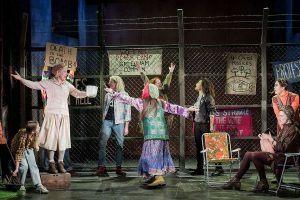Beyond the Fence is the world’s first computer generated musical, created by Benjamin Till and a team of researchers.

Not only is 25% of the music and lyrics computer generated, but aspects of the production such as the setting and size of the cast were based on algorithms as well. Using an algorithm that sorts through over 2,000 musicals, they determined the characteristics of the best musicals and applied those to the premise of the musical. After computing these aspects of the plot, they team filled “in the dots.”
There’s a hint of Romeo and Juliet (or should that be West Side Story?) to the burgeoning relationship between Mary and Jim, a touch of Miracle on 34th Street to the George subplot, and the idea of a band of women taking a stand against oppressors has been rehearsed in the West End as recently as last year’s short-lived musical staging of Made in Dagenham.
This project is extremely interesting because most modern arguments suggest the computer will never be as creative as the human, especially concerning emotional factors, but this project applied creativity in a useful way. After computing the aspects of the plot, the team filled “in the dots.” With most computer generated work, there is a layer of human decision making (even going back to the creation of the algorithm) so things such as the dialogue and blending the lyrics from the poetry generator were created at the hands of the team. Somewhat relying on the machine to inspire their own creativity. With the advantageous use of these algorithms, the reliance on the “What-If Machine” allowed the team to use their talents elsewhere and fall prey to the surprising output of the machine.
The music was created with the algorithmic composing software, Android, the plot-generating script, PropperWryter, and lyric-generating, Clarissa the Cloud Lyricist, with their own software the “What-If Machine.” It was a collective effort of many collaborators and creators to fully realize this computational musical.
This project as a reference for sound art, is quite inspiring to go past the so-called restrictions of machine-learning and computer generated software’s to create something brand new, yet realistic and familiar. It would be really interesting to see what would happen if these algorithms ran throughout the musical, constantly changing its plot and premise- almost like an improv.
![[OLD FALL 2018] 15-104 • Introduction to Computing for Creative Practice](https://courses.ideate.cmu.edu/15-104/f2018/wp-content/uploads/2020/08/stop-banner.png)